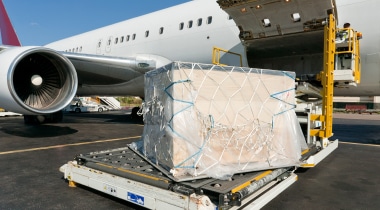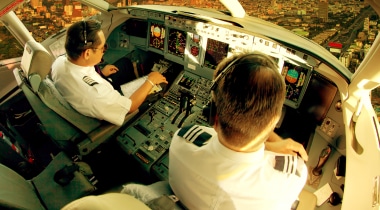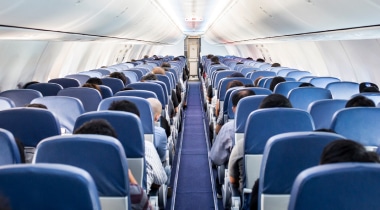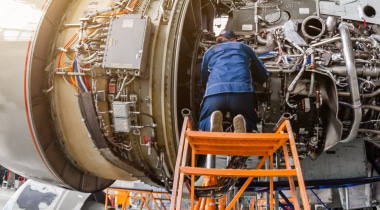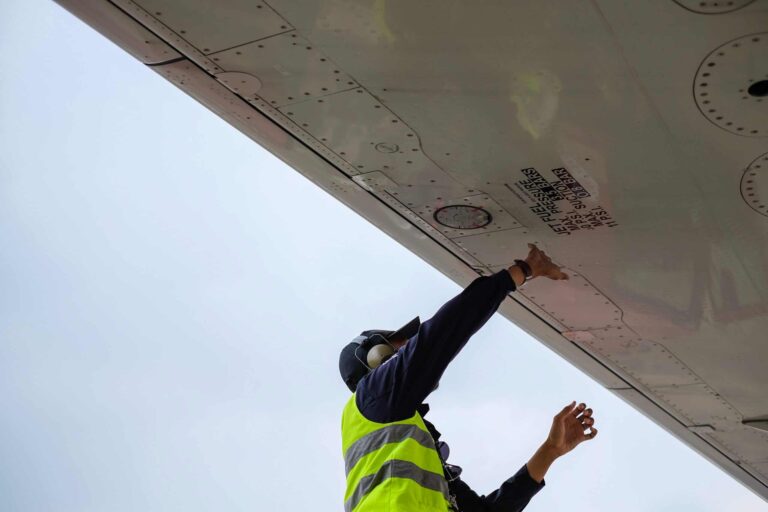Whether to satisfy a casual interest in aviation or address the need to learn about it for your profession, it’s understandable that one might have a tough time memorizing the formal definitions of aviation terms. The world of aviation practically has its own language. To master it, use a list of common, and not-so-common, terms compiled by Proponent as a study aid. By making time to read and practice this vocabulary regularly, a dedicated hobbyist or aspiring pilot can make steady progress toward their goals, becoming “fluent” in the language of aviation.
A
Absolute Altitude: The distance from the ground to the aircraft while it’s flying. It is measured by using a tool called an altimeter.
Absolute Ceiling: The maximum altitude an aircraft can reach under standard conditions, determined by its weight and engine power, beyond which it cannot climb further. It is a crucial factor for flight planning and operational limitations.
Accelerated Stall: Occurs when an aircraft surpasses its critical angle of attack while experiencing increased speed or load factor. It leads to a sudden loss of lift and control, often during aggressive maneuvers or high-speed turns. Recovery requires prompt corrective actions to regain control and restore lift. Pilots must be aware of this risk and understand the aerodynamics involved to maintain a safe flight.
ADS-B: Also known as Automatic Dependent Surveillance-Broadcast, is an aviation technology that uses GPS to enable aircraft to determine and broadcast their position, altitude, and other data. It enhances air traffic management, improves situational awareness, and promotes safer and more efficient flight operations.
Adiabatic Lapse Rate: A mathematical formula measuring the rate of change in atmospheric temperature depending on decreases or increases in altitude in thermal equilibrium.
Adverse Yaw: The tendency of the aircraft’s nose to turn in the opposite direction of a turn.
Aeronautical Information Manual: Abbreviated by the acronym AIM, is an official document produced and distributed by the Federal Aviation Administration to instruct pilots in proper aircraft operation within the U.S. National Airspace System.
AGL: Stands for Above Ground Level, and it is used in aviation to measure the height or altitude of an aircraft or object relative to the ground directly beneath it.
Aileron: Hinged surfaces at the trailing edges of an aircraft’s wings to help it stay balanced.
Airfoil: The cross-sectional shapes created by wings, rotors, turbines, and blades when the aircraft lifts.
Air Defense Identification Zone: The airspace over land and water in which a civil aircraft’s location, identification, and control are monitored for the sake of national security. Also called ADIZ.
Air Speed Indicator: An aviation instrument that measures and displays an aircraft’s speed relative to the surrounding air. It uses a pressure system to convert differential pressure into airspeed readings (mph, knots), helping pilots maintain safe and efficient flight operations. Also known as ASI
AirTaxi Operator: A company that offers on-demand air transportation using small aircraft or helicopters. They provide quick and efficient travel for individuals or small groups between urban areas, airports, or remote locations. By utilizing advanced technology and digital platforms, they streamline booking, scheduling, and payment processes. AirTaxi Operators offer a convenient and flexible alternative to traditional airlines, focusing on personalized and swift transportation services.
Air Traffic Control: A service that directs aircraft on the ground and within a specific airspace, in addition to advising aircraft outside their designated airspace, in order to avoid collisions. Also known as ATC.
Altimeter: An instrument in the cockpit that uses air pressure to calculate the aircraft’s altitude.
Angle of Attack: The angle created with an airfoil’s chord line and the direction of the air that passes through it.
Anhedral: The downward angle produced by a wing’s relation to the horizontal cross-sectional line of the wings. It enhances stability and maneuverability, especially at lower speeds or in adverse conditions. Anhedral wings reduce unintentional rolling and are commonly found on transport planes, helicopters, and some light general aviation aircraft.
A&P: Stands for Airframe and Powerplant Mechanic. It refers to certified technicians who inspect, maintain, repair and overhaul aircraft structures and engines. Airframe involves the aircraft’s structure, while Powerplant relates to the engines and associated systems. A&P mechanics undergo rigorous training and examinations to obtain their certification, which is essential for employment in the aviation industry.
Apron: A designated space at an airport at which an aircraft can park for fueling and loading.
Auxiliary Power Unit: Also known as an APU, is a self-contained power source on an aircraft. It provides electrical power and pneumatic pressure when the main engines are off. The APU supplies electricity for onboard systems and air pressure for engine starting and other functions. It eliminates the need for external power on the ground and serves as a backup in flight. The APU enhances aircraft functionality, safety, and passenger comfort.
Automatic Direction Finder: A radio navigator that automatically indicates an aircraft’s bearing to a radio station based on signals in the LF or MF bandwidth. Also called ADF.
Automatic Terminal Information Service: A pre-recorded compilation of information specific to aviation to help pilots navigate particular terminals. Also known as ATIS.
Aviation Alphabet: The practice of using unmistakable words to indicate the letters necessary to spell out another word in order to avoid confusion. For example, A is for alpha, so when spelling a word that needs the letter A, simply say, “Alpha.” Outside aviation, this is called the phonetic alphabet.
AWIS: Also known as an Aviation Weather Information Service is a system providing real-time meteorological data and forecasts specifically for aviation. It enables informed decision-making by offering current weather conditions, forecasts, and hazard assessments, ensuring safe and efficient flight operations.
B
Base Leg: A flight path descending in the direction of an airport runway.
Bleed Air: Condensed hot air emitted by the engine and used to heat and de-ice the jet at high pressure.
Black Box: An electronic flight recorder that keeps track of the flight’s altitude, speed, and position, along with any discussions between the pilots.
Block time: The measurement of time between the plane’s departure from its gate and its arrival at the next.
C
Calibrated Airspeed: The airspeed when taking position and instrument inaccuracy into account.
Call Sign: A unique combination of letters or numbers assigned to an aircraft or pilot for clear communication with air traffic control and other aircraft. It helps identify and differentiate aircraft and pilots, ensuring efficient and safe communication in busy airspace.
Camber: The degree of convexity in an airfoil’s curve.
Cargo: Goods, products, and other items carried in an aircraft.
Ceiling: The altitude of the lowest cloud or similar material obscuring the view.
Ceiling and Visibility Unlimited: Describes optimal flying conditions, characterized by the ability to see ten miles out and ten thousand miles down. Also called CAVU.
Certificate of Airworthiness: A Certificate of Airworthiness is an official document issued by aviation authorities, certifying that an aircraft meets safety and airworthiness standards for operation. It proves the aircraft has been inspected, tested, and complies with regulations. It is a legal requirement for flight and must be periodically renewed.
Chord Line: The invisible line stretching between an airfoil’s foremost edge, or its leading edge, and its rear edge, or tailing edge.
Civil Aviation Authority: The Civil Aviation Authority (CAA) is a regulatory body that oversees and governs the aviation industry, ensuring safety, efficiency, and security. It sets and enforces regulations for aircraft operations, pilot licensing, air traffic management, airport operations, and more. The CAA also handles economic regulation, competition promotion, and passenger rights protection. Its role is vital in maintaining and advancing civil aviation. The CAAC is the Civil Aviation Administration of China headquartered in Beijing.
Codeshare Flight: When two or more airlines collaborate to operate a flight under their own codes. Passengers can book tickets with one airline but travel on a flight operated by a partner airline. This arrangement expands route networks and offers passengers seamless travel experiences and benefits across multiple airlines.
Constant-Speed Propeller: A propeller built to automatically change the angles of its blades so that the engine has a steady RPM.
Course Deviation Indicator: An instrument that indicates when and by how much the aircraft is veering off-course. Also called CDI.
Controlled Airspace: Controlled airspace refers to designated regions where aircraft movement is regulated by air traffic control (ATC). It ensures safe and efficient traffic flow, with ATC providing instructions and clearances. Pilots must comply with procedures and communicate with ATC for safety.
Crosswind: Wind blowing across the aircraft’s course.
D
Deadstick: Forcing the aircraft to land when the propeller and engine cease to function.
De-icing: De-icing in aviation is the process of removing ice, frost, or snow from an aircraft’s surfaces to ensure safe flight by using fluids or mechanical methods. It prevents aerodynamic issues and improves aircraft performance in wintry conditions.
Distance Measuring Equipment: A device that calculates the distance between the aircraft and a ground station using radio navigation.
Distress: Urgent trouble on the aircraft that must be resolved immediately.
Downwash: Air pushed down by a wing or rotor blade, often as the aircraft ascends.
Downwind Leg: A flight course parallel to the runway but heading in the opposite direction.
Drag: A force moving opposite but parallel to the aircraft’s course.
E
EASA: An abbreviation for the European Union Aviation Safety Agency, ensures aviation safety and regulatory harmony within the EU. It sets and enforces high standards in areas like aircraft certification, operational regulations, licensing, and inspections. EASA’s work enhances the safety and efficiency of air transport in Europe.
Emergency Overrun: A clear area on the runway designed to prevent as much damage as possible to an aircraft if it cannot stop.
Empennage: Another word for an aircraft’s tail, consisting of a fin, rudder, and stabilizer.
Equal time point: The moment during a flight when two or more destinations become equidistant in terms of flight time. It is a critical decision-making point for pilots, determining whether to continue to the original destination or divert to an alternative location due to unforeseen circumstances.
Eurocontrol: An intergovernmental organization responsible for coordinating air traffic management across Europe. It ensures safe, efficient, and environmentally sustainable aviation operations by harmonizing standards, procedures, and technologies. They oversee the Single European Sky initiative, facilitate information exchange, and provide critical services for airspace management.
F
Feathering: Minimizing drag by adjusting the pitch propellers to match the airflow.
Federal Aviation Administration: An organization authorized by the U.S. government to monitor and manage civil aviation. Also known as the FAA.
Federal Aviation Regulations: Also known as FARs, are the rules that govern civil aviation in the United States, which were created and enforced by the FAA.
Ferry Flight: The act of relocating an aircraft from one place to another without passengers or cargo. It is primarily done for repositioning purposes, such as delivering new aircraft, transferring between airlines, or moving for maintenance. These flights require careful planning and adherence to safety protocols and regulations. Ferry flights contribute to the efficient movement of aircraft and enhance operational flexibility in the aviation industry.
Firewall: A fireproof bulkhead, or barrier, placed between the engine and other parts of the aircraft.
Fixed Base Operator: A private airport-based business that fuels, maintains, repairs, hangars, and parks aircraft, in addition to training pilots and offering charter services. Also known as an FBO.
Flaperon: Control surfaces on an aircraft’s wings meant to let the pilot manage a roll or bank.
Flaps: Movable surfaces on the wings that change the wing’s shape and performance. They are extended during takeoff and landing to increase lift and control. Different types of flaps offer various degrees of extension and aerodynamic effects. Flaps play a vital role in safe and efficient flight operations.
Flare: The maneuver of pulling the aircraft’s nose upward as it descends and prepares to land.
FLARM: An aviation system known as Traffic Alert and Collision Avoidance System (TCAS). It enhances flight safety by detecting nearby aircraft using GPS and radio technology. It provides alerts to pilots, helping them avoid potential collisions by altering course or altitude. Popular in glider and light aircraft operations, FLARM improves situational awareness and prevents mid-air accidents.
Flight Data Recorder: Abbreviated as FDR and also known as a “black box”, is an essential device in aviation that collects and stores flight data, including aircraft performance, control inputs, and environmental conditions. It aids in accident investigations and operational analysis.
Flying Dirty: An expression to describe an aircraft flying with landing gear out, extended flaps, and other surfaces deployed in order to create drag causing the plane to slow down.
First Officer: A First Officer in aviation is the co-pilot and second-in-command of a multi-crew aircraft. They assist the Captain, handle aircraft systems, communicate with air traffic control, and follow procedures to ensure safe and efficient flights.
Fuselage: An aircraft’s main body.
G
Go-Around: The decision of a pilot or the air traffic control to have the aircraft circle around the runway and try again to land.
Gone Tech: a technical malfunction or failure of a specific aircraft system, component, or instrument during a flight. It signifies that the affected technology is no longer functioning correctly and requires maintenance or repair before the aircraft can resume normal operations.
Grounding: Grounding in aviation is the temporary suspension of aircraft due to safety concerns or regulatory issues. It involves removing aircraft from service until repairs or inspections are completed to ensure safe operation.
Ground Proximity Warning System: Abbreviated as GPWS. It is a crucial safety feature in aircraft that uses sensors and alerts to help pilots be aware of the aircraft’s proximity to the ground and avoid accidents. It compares the aircraft’s flight profile with a database of terrain maps and obstacles, providing warnings when necessary.
H
Hand-off: In aviation, a hand-off refers to transferring control and monitoring of an aircraft from one air traffic controller to another. It involves exchanging essential information and ensuring a smooth transition for safe and efficient flight management.
Handshake: The initial log-on or “ping” operation in aeronautical satellite communication (SATCOM) systems. It marks the start of communication by requesting and establishing the connection.
Hangers: Hangers in aviation are large enclosed structures designed for the storage, maintenance, and protection of aircraft.
Horizontal Stabilizer: A small lifting surface that helps the aircraft stay stable from the edge of the tail.
Hypoxia: The state of having too little oxygen. Symptoms include rapid breathing, dizziness, reduced heart rate, confusion, etc.
I
Indicated Airspeed: The measure of an aircraft’s speed as displayed on its instrument panel, calculated by measuring the dynamic pressure of the air flowing around the aircraft and adjusting for instrument and position errors. Also known as IAS.
International Air Transport Association: A global trade association representing the airline industry, facilitating safe, secure, and efficient air transport by setting industry standards, promoting collaboration among airlines, and advocating for the interests of the aviation community worldwide. Also known as IATA.
International Civil Aviation Organization: A specialized agency of the United Nations that establishes and promotes global standards and regulations for safe, secure, and efficient international civil aviation operations. Also known as ICAO.
Instrument Flight Rules: A set of rules that allow pilots to plan for flying under diverse meteorological conditions. Also known as IFR.
Instrument Landing System: A system that uses radar to help aircraft land safely, regardless of meteorological conditions. Also called ILS.
Instrument Meteorological Conditions: Refers to the weather conditions in which aircraft navigation and flight are primarily reliant on the reference instruments, as visibility and external visual references are significantly limited or absent, requiring pilots to rely on instruments for safe and precise navigation. Also known as IMC.
Integrated Standby Flight Display: A backup instrument panel that provides flight information, such as attitude, altitude, airspeed, and navigation data, in the event of a primary flight display failure. Also known as ISFD.
J
Jet: An aircraft with engines capable of flying at or above the speed of sound.
Jetway: Also known as an aerobridge or passenger boarding bridge, is a movable enclosed walkway that connects an airport terminal gate directly to an aircraft, enabling passengers to board or disembark the plane in a sheltered and convenient manner.
Joystick: A hand-operated control device used by pilots to manipulate the flight controls of an aircraft, typically consisting of a vertical stick that enables precise control over pitch and roll movements.
K
Knot: A unit of speed measured by a single nautical mile or 1.15 statute miles which is the equivalent of 6076 feet per hour.
L
Landing Gear: The undercarriage of an aircraft, assisting in takeoff, taxiing, and landing, in addition to offering structural support.
Level Flight: Keeping the aircraft at a steady altitude.
Lift: The upward force exerted on an aircraft’s wings or airfoil due to Bernoulli’s principle and the shape of the wings, allowing the aircraft to overcome gravity and stay airborne.
Lighter-than-air craft: An aviation vehicle that achieves lift and buoyancy by utilizing gasses, such as helium or hot air, to make it float in the air without relying on aerodynamic forces generated by wings or propellers. Some examples are blimps and hot air balloons.
Longitudinal Axis: An invisible line cutting horizontally across the center of gravity, used for orientation.
M
Mach: A ratio measuring airspeed against the speed of sound in the air through which the aircraft is flying.
Magnetic Compass: A device that indicates the aircraft’s directional orientation relative to the north and south poles.
Magnetic Deviation: Technological errors caused by the magnetism of aircraft instruments.
Mean Sea Level: The average height of sea level.
METAR: An abbreviation for the Meteorological Aerodrome Report, is a standardized format used in aviation to provide concise and up-to-date meteorological information for a specific aerodrome, including temperature, wind speed and direction, visibility, and other important weather conditions.
Mountainous Terrain Escape Routes: Predetermined flight paths or corridors that are specifically designated to provide safe passage for aircraft in the event of an emergency or when flying through challenging mountainous regions, allowing pilots to navigate through the terrain and reach a safer location.
N
N Number: A U.S.-registered aircraft’s registration number.
Narrow-Body Aircraft: a small aircraft class with a slender fuselage design featuring a single aisle inside, capable of carrying up to 300 passengers.
National Transportation Safety Board: Also known as NTSB, is a U.S. federal agency responsible for investigating and determining the causes of accidents and incidents in the field of aviation, intending to promote safety and prevent future accidents.
North Atlantic Tracks: Also known as the North Atlantic Organized Track System (NAT-OTS), are a specified set of routes that stretch Eastbound and Westbound across the North Atlantic, requiring aircraft to obtain oceanic clearance to fly them; these tracks ensure safety by maintaining separation between aircraft and considering optimal weather conditions.
Navaid: A shortened term for “navigational aid,” referring to any device or tool that helps the pilot navigate.
O
Oil Pressure Gauge: An instrument that indicates the pressure of the engine’s lubricating oil.
Operating Limitations: An aircraft’s maximum speed, pressure, weight, and capacity for holding passengers and crew members.
Overshoot: The act of exceeding the intended touchdown point or the planned flight path during a landing approach or navigation, often resulting in a longer or off-target landing.
P
Pilot in Command: The pilot in charge of the aircraft’s security and operation from takeoff to landing.
Pilot’s Operating Handbook: Abbreviated as POH, is an aircraft manual that provides essential instructions and information for safe and efficient operation.
Pitch: Movement on the aircraft’s lateral axis from wing to wing, affecting the front end’s ascent and descent.
Primary Flight Display: An electronic screen showing the aircraft’s airspeed, vertical speed, altitude, rate of turn, and other important information.
Q
Quadraplane: An aircraft with at least four similarly-sized wings.
R
Radar Approach Control Facility: A terminal-based facility run by either the military or civil organizations to help aircraft that are landing, taking off, or flying through controlled airspace, using both radar and non-radar equipment. Also called RAPCON.
Registration or Tail Number: A government-issued number on the exterior of the aircraft for the purposes of identification.
Report Time: The time that the aircraft’s crew must arrive at the airport to prepare for the flight, usually anywhere from half an hour to an hour before the passengers are due to board.
Roll: The rotational motion of an aircraft around its longitudinal axis, causing the wings to tilt and the aircraft to bank left or right.
Rudder: A movable control surface located at the rear of an aircraft that is used to control and stabilize its yawing motion by deflecting to the left or right.
Runway: A specified stretch of ground designed to accommodate takeoffs and landings.
S
Short Field: An unusually short runway that requires the pilot to land or take off quickly.
Sideslip: An aircraft maneuver characterized by aligning with the lateral force of the wind, inducing a sideways flow.
Soft Field: An unpaved runway, often covered with grass or dirt, which necessitates specific landing and takeoff techniques due to its uneven and loose surface.
SQUAWK: A four-digit number for identifying an aircraft when a pilot communicates with ATC.
Stall: When the angle of attack is severe enough to prevent air from passing smoothly over the airfoil.
T
Tarmac: The Area of an airport where aircraft are parked, loaded, unloaded, or refueled.
Traffic Collision Avoidance System: Abbreviated as TCAS, is an aviation safety technology that uses radar and transponder data to detect and prevent potential mid-air collisions between aircraft by providing pilots with timely alerts and instructions for evasive maneuvers.
Threshold: A designated area of the runway on which the aircraft can land.
Throttle: A valve that manages the amount of fuel allowed in the engine.
Thrust: A force generated by the propeller to reduce drag and push the aircraft forward.
Torque: A force that causes a twist designed to create rotation.
Touch-and-Go: A maneuver where an aircraft lands briefly on a runway and immediately takes off again without coming to a complete stop.
True Airspeed: An aircraft’s airspeed after including temperature and altitude in the calculation.
True Altitude: An aircraft’s altitude from mean sea level.
Turbosuperchargers: A device that enhances the performance of a combustion engine with a device that uses turbine energy to increase pressure by compressing air.
U
Upwind Leg: A parallel flight path to that of the aircraft heading in the same direction as the runway.
V
Vertical Speed Indicator: An instrument that evaluates the shifts in atmospheric pressure to determine the rate of the aircraft’s ascent or descent. Also known as a VSI.
Very High-Frequency Omnidirectional Range: A navigation system that lets the aircraft clarify its position and direction through short-range radio signals with beacons on the ground. Also called VOR.
Visual Flight Rules: A set of rules that govern aircraft operations when pilots are using visual references. Also called VFR.
Visual Meteorological Conditions: The weather conditions that allow VFR.
W
Weight-Shift-Control: A flight control system where an aircraft’s maneuverability is achieved by shifting the pilot’s body weight to control the aircraft’s pitch and roll.
Wide-Body Aircraft: An airplane featuring two aisles inside, with a typical fuselage diameter ranging from 16 to 20 feet.
Wilco: A term indicating that you will follow the instructions given.
Wind Shear: A sudden shift in wind speed and direction.
Y
YAW: The aircraft’s movement from side to side.
Yoke: The wheel that controls the aircraft’s movement, pitch, and altitude.
Z
Zulu Time: A method for telling time used by all flight plans, characterized by the use of the 24-hour clock. Other common terms are Greenwich Mean Time (GMT), Universal Coordinated Time (UTC), and military time.
Progress with Proponent
Although there are a lot of aviation terms to learn, it’s doable with time and effort. Make flashcards to study whenever a spare moment presents itself. Soon enough, every word from this list will come as naturally as your everyday conversational language.
Whether you are just entering the aviation world or are an expert in your craft, it is important to know about Proponent and the value we can add to your specialty. As a value-added distributor in the aerospace industry, we offer top-tier products and services that improve every aspect of the aviation supply chain. To learn more about Proponent and the high-quality solutions we offer, contact us.

